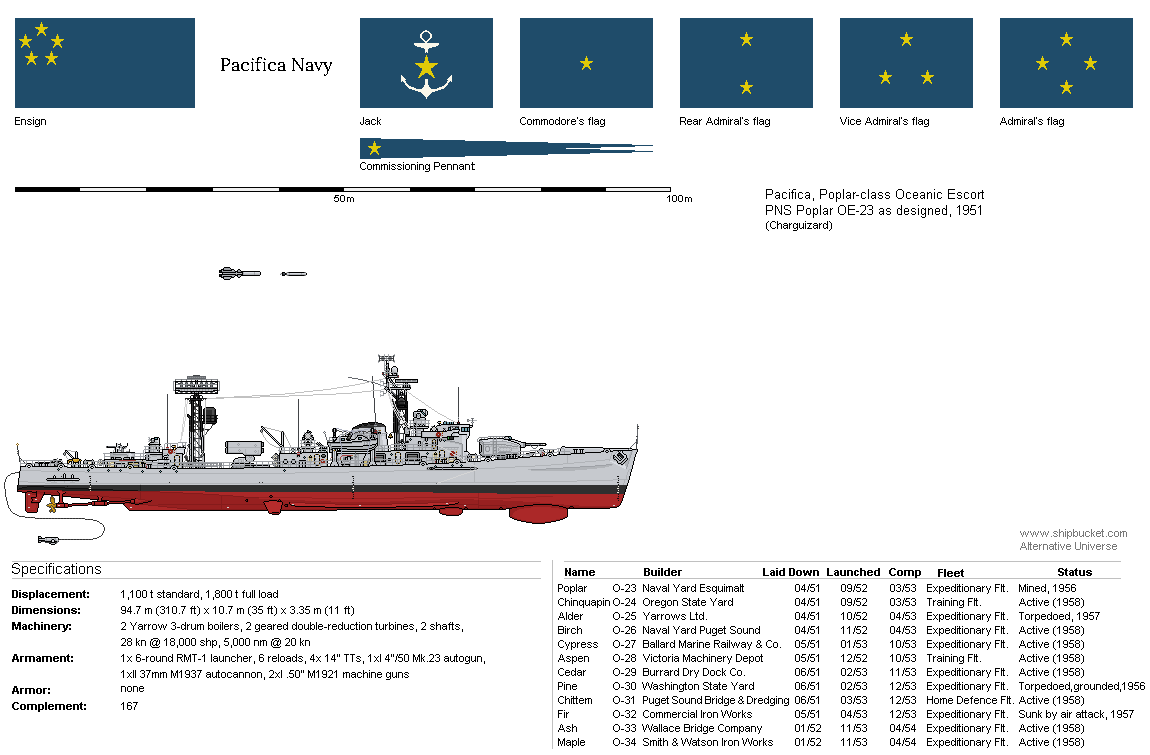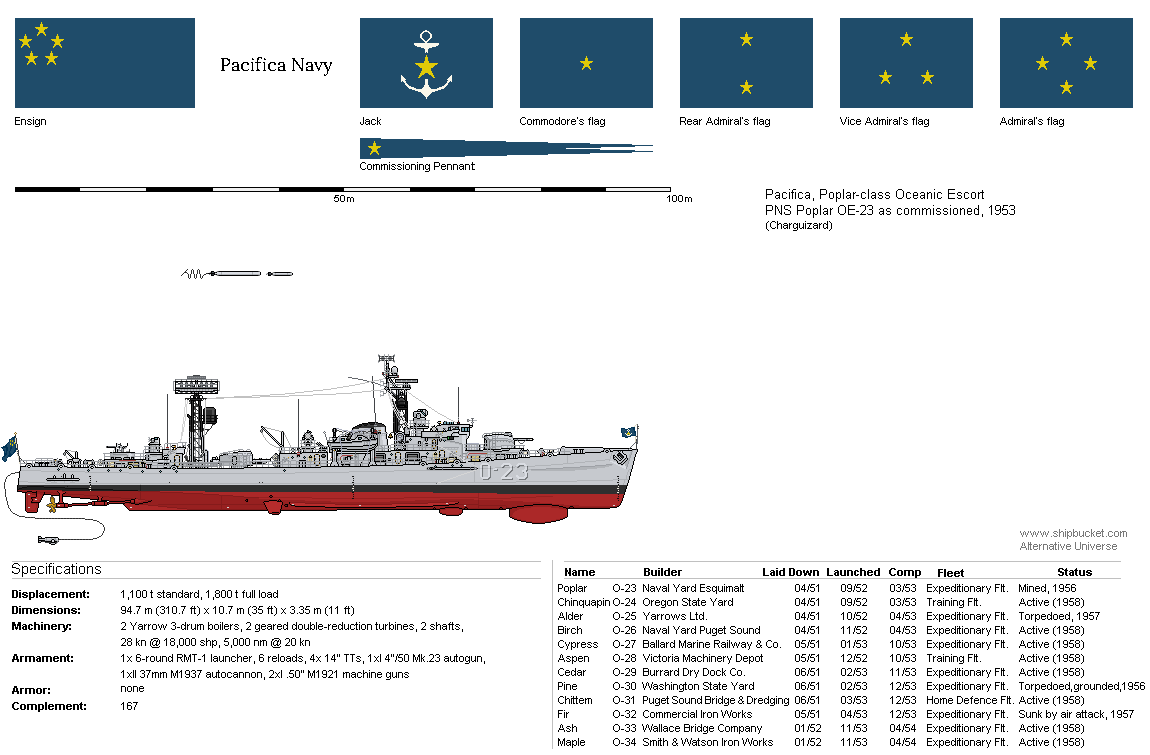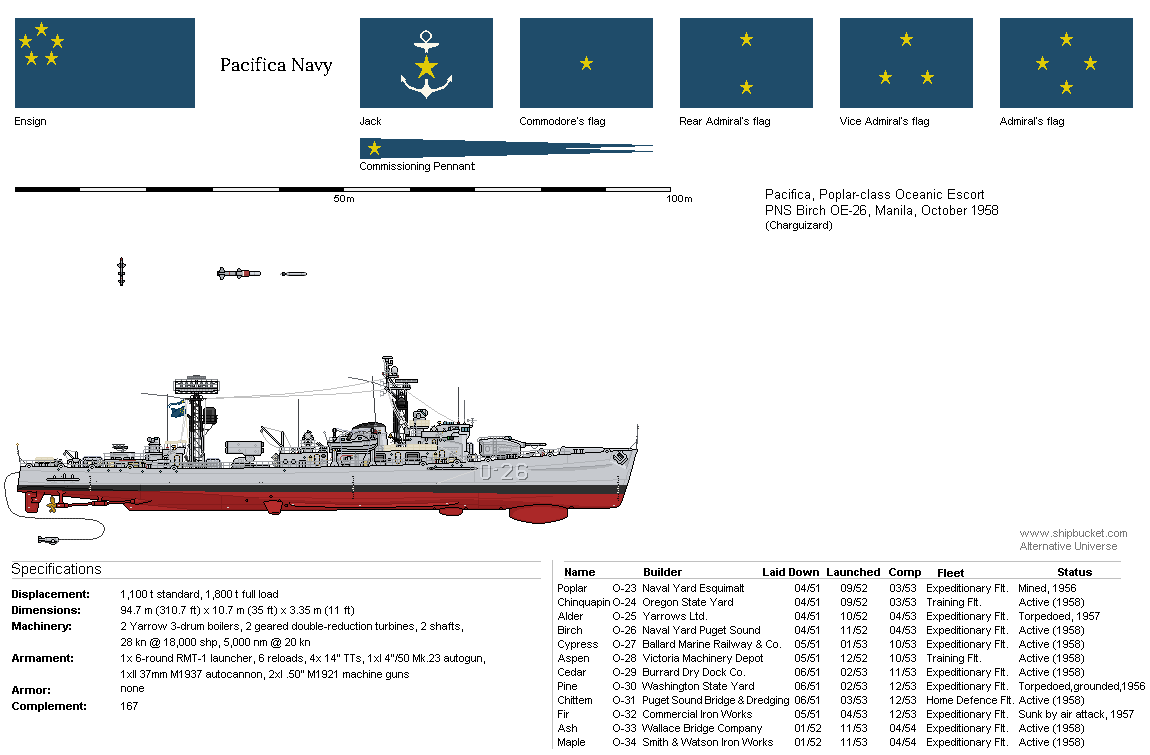Poplar-class oceanic escort
By 1950 the original Oceanic Escorts of the Pacifica Navy were nearing 20 years of age; obsolescence had come en-block a while ago already. The lessening of the pirate threat and the winding down of conflict in North America meant that their numbers were more important than their individual capabilities, and the remaining CYPRESS and PINE class ships soldiered on, herding merchants across Big Blue. But anti-submarine and anti-aircraft warfare had taken great leaps, beyond what these hulls could offer, and thus a new ship design was devised from scratch. The submarine remained the main threat against convoyed merchants, older Aircraft Carriers would provide the necessary air cover for these anyways, so ASW was the main focus, yet again, for the next generation of Pacifican Oceanic Escorts. Current state of the art in anti-submarine warfare was the projected 53FU6 low-frequency SONAR, a large and heavy set with an enormous 20 ft transducer that was expected to detect targets at over 10,000 yards, and the RMT-1 “Alabaster” Torpedo delivery vehicle for the 14” Mark 18 torpedo, currently undergoing trials. These systems determined the minimum size and power requirements for the ship, and a 300 ft Destroyer hull was chosen to deploy this very specialized platform. Central to the ship was the Alabaster installation, consisting of a six tube box launcher on a fully-remote-controlled rotating platform, with six reloads on a vertical magazine next to the launcher. The gigantic SONAR dome was installed close to the bow of the ship, which dictated a rather fuller hull shape forewards than desired, but the ship nevertheless retained fine hull lines. The hull would then be dominated by the powerplant, consisting of two Yarrow 3-drum boilers with superheaters and economizers, running at 580 psi (4,000 kPa), superheated to 842 °F (450 °C) and two Parsons-type geared turbines driving two shafts, producing 16,000 hp for 28 knots. This speed, plenty enough for convoy duty but lower than the 30 knot threshold, classified these ships as Oceanic Escorts instead of Fleet Escorts, like the contemporary NOOTKA class.
As the ship took form, other systems found their way to round out the ship’s capabilities. The 53FU6 set was backed up by a 44FU3.75 targetting SONAR, and supported by a 38TUP “electric eel” towed hydrophone, while the ASW armament was rounded up by four fixed torpedo tubes for 14” Mark 18 acoustic homing torpedoes. For the main surface and anti-air armament, a new 4”/50 Mark 23 fully automatic gun was chosen, which was projected to be a better match for small surface combatants than current and future 5” guns. This gun consisted of the familiar 4 inch 50 caliber barrel, mounted forward of the trunnion to enable simple mechanical loading at any angle of elevation, which was performed by a hoist coming up from the ammo handling room, which fed a hopper which in turn fed a curving, extendable cage that ended on the gun breech tray, whose spring was cocked pneumatically for the first shot and subsequently recocked by recoil action. This gun would be directed by the Mark 41 director, placed just abaft the bridge, on a short tower in front of the foremast. The anti-aircraft armament was then rounded up by a twin 37mm M1937 water-cooled autocannon directed by a Mark 32 simple tachymetric enclosed director with integrated rangefinding radar, and two of the ancient but trusty Browning .50” M1921 machine guns on pintle mounts. Other equipment include 52RS140 early warning radar mounted on the mainmast, 50RS5 surface search and navigation radar mounted on the foremast, 49RSP radar direction finder mounted on the foremast wings, 51FJ10 S-band jammer mounted on the foremast top, 41RB100 aircraft homing beacon mounted just behind it, 39RJ6 trainable jammer mounted on a dome on the mainmast, 39FMP monitoring antenna mounted on the sides of the foremast, oropesa gliders and paravanes for minesweeping, and two M1947 Window grenade launchers.
The first ship, PNS Poplar, was laid down on April 1951, at the Naval Yard Esquimalt, and five others soon followed suit in both state and private yards, for what would end up as a class of 12. Alas, what seemed simple in paper wasn’t in practice, neither the 4” Mark 23 gun nor RMT-1 were ready in time for POPLAR’s completion in 1953, so this ship and the following 3 sisters, ALDER, BIRCH and CYPRESS, were completed with a manually loaded 4”/50 Mark 18 twin “thimble” BD mount on the bow, and the familiar 24” quintuple torpedo tube mount, which was adapted to RPC and equipped to fire wire-guided 24” “Oryx” torpedoes or sabotted 14” Mark 18 torpedoes. The other ships were delayed long enough that they received their intended equipment as delivered. Eventually, with the success of both the Mark 23 gun and Alabaster, ships were scheduled to be refitted with their intended equipment, but none had undergone this by the start of the Eurasian conflict in 1955. Later in their lives, surviving ships of the class exchanged their M1937 37mm mount for the GIM-4 “Consul” surface to air infrared guided missile, a small, short range defense system designed to have little ship impact and replace air defence guns on escorts and merchants, swapped the M1921 .50” machine guns for 1.2” M1940 autocannon in partial compensation, but also received the much more accurate RMT-2 “Axiom” torpedo delivery vehicle, replacing Alabaster and firing from the same launcher.
Once out at sea, it was found that these ships presented uncomfortable movements in heavy weather, undoubtely caused by the fuller hull forms forewards. Another disadvantage was how little volume remained for the crew on a ship that was cramped from the outset, berthing and mess standards were not on par with other ships entering service at this time, which was never satisfactorily addressed. This also had the disadvantage of giving the hulls little grow margin for the future. Nevertheless, the POPLAR class ships proved to be as capable at hunting submarines as their equipment foresaw, they gave sterling service accompanying convoys across the Pacific ocean, to South America, Oceania, East Asia and even into the Indian Ocean, with several confirmed kills and many more engagements against VMF underwater raiders, but also a few against aircraft and even surface ships.


